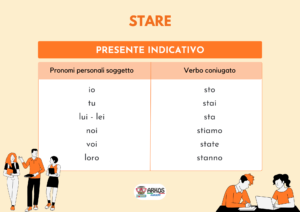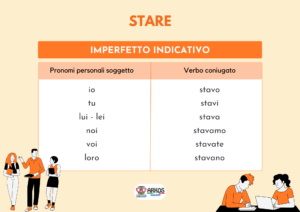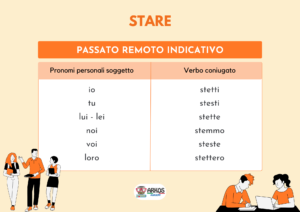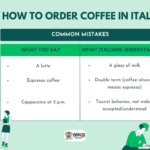Introduction
The verb “stare” is one of the most important and versatile verbs in the Italian language. If you are wondering how to use ‘stare’ in Italian, this article will provide you with a comprehensive understanding of its meaning, usage, and key expressions. Unlike many other verbs, it holds a special place in both formal and informal contexts.
While it is often confused with the verb “essere”, “stare” carries its own distinct nuances that make it indispensable in daily conversations. Unlike “essere”, which is used to describe identity or more permanent states, “stare” is frequently employed to highlight temporary conditions, ongoing actions, or physical locations.
This is why phrases like “sto bene” (I am well) or “sto lavorando” (I am working) are so common in everyday Italian.
Additionally, “stare” appears in many idiomatic expressions, like “stare attento” (be careful) or “stare in forma” (stay in shape), which further emphasizes its flexibility.
Moreover, in some contexts “stare” can also be replaced by the synonims restare, rimanere.
In this article, we will explore the core characteristics of “stare” and explain its varied uses.
You’ll discover how to use ‘stare’ in Italian, how to conjugate it, learn how to recognize its role in common expressions and see how it works within progressive tenses. Each section is enriched with practical examples that will give you a deeper understanding of this essential verb and how to use ‘stare’ in Italian in your conversations.
How to Use ‘Stare’ in Italian: Its Characteristics and Meaning
Basic Meaning
The verb “stare” can be translated into English as “to stay” or “to be”. However, its meaning can vary depending on the context and the way it is used in a sentence. Unlike the verb “essere,” which is often associated with more permanent states or identities, “stare” frequently describes temporary conditions, actions in progress, or physical positions.
Here are some of its main meanings explained in greater detail.
How to use ‘stare’ in Italian:
- Physical position: This usage refers to where a person, animal, or object is located at a specific moment in time. It emphasizes the act of being in a place, but not necessarily permanently. For instance, when you say “Io sto a casa” (I am at home), it implies that you are there at the moment or for a certain amount of time, but you might leave later. This is different from saying “Io sono a casa,” which could sound more definite.
- Example: “Io sto a casa.” (I am at home.)
- Example expanded: Imagine you call a friend and ask, “Where are you?” If they reply, “Sto a casa,” they are telling you that, at this precise moment, they are at home or they’re planning to stay there for a period.
- Condition or state: “Stare” is often used to describe a temporary condition, such as health, mood, or well-being. This is especially common in daily conversations where you ask someone how they are doing. The response, “Sto bene” (I am well), illustrates this use perfectly. This type of sentence focuses on the present condition of the person, which can change over time.
- Example: “Luca sta bene.” (Luca is well.)
- Example expanded: Suppose you ask about your friend who was sick last week. Someone might tell you, “Luca sta bene,” meaning that right now, Luca is feeling better. The use of “stare” in this context shows that it refers to his current condition.
- Duration: In certain cases, “stare” can also imply the idea of staying in a particular state or location for a certain length of time. This usage highlights a more continuous presence. When someone says, “Rimarrò qui fino a domani” (I will stay here until tomorrow), they emphasize their ongoing presence in that location. Here, “stare” can sometimes be used in combination with other verbs to express duration. The tenses used in this context are often the present tense (presente indicativo) and the simple future (futuro semplice indicativo).
- Example: “Rimarrò qui fino a domani.” (I will stay here until tomorrow.)
- Example expanded: Imagine you’re traveling and someone asks you how long you plan to stay in a city. If you respond, “Starò qui fino a domani,” you’re emphasizing that you are going to be present at that location for a defined period. The idea of “staying” for a specific duration is central to this meaning.
As you can see, the verb “stare” is versatile. It changes meaning depending on the specific context and the other words in the sentence (and there is another common situation to learn about how to use ‘stare’ in Italian!). Understanding these differences is key to using “stare” correctly in Italian conversations. Whether you’re telling someone where you are, how you’re feeling, or how long you’ll remain somewhere, “stare” becomes a vital tool for effective communication.
Master the Conjugation of ‘Stare’ in Italian: Forms and Examples
The verb “stare” is irregular, and its conjugation varies depending on the tense and person.
In this section, we will focus on the simple tenses of the indicative mood: present (presente), imperfect (imperfetto), simple past (passato remoto), and simple future (futuro semplice).
If you have questions or want to deepen your understanding of how to use ‘stare’ in Italian with the correct verbal tense or modo, you can book a lesson with a native Italian teacher.
Here is the conjugation in the present indicative:




Everyday Expressions with ‘Stare’ in Italian (With Examples)
“Stare” is often used in idiomatic expressions and common phrases that are essential for effective communication in Italian. Understanding these expressions not only helps you sound more natural, but it also enhances your comprehension of spoken Italian.
Here are some of the most common expressions and their meanings:
- Stare attento: To be careful or vigilant. This expression is widely used in everyday life to warn someone to pay attention to a specific situation or action. It is often heard from parents, teachers, or friends.
- Example: “Stai attento quando attraversi la strada.” (Be careful when crossing the street.)
- Example expanded: Imagine a parent speaking to their child before they cross a busy road. They might say, “Stai attento quando attraversi la strada,” to remind them to be aware of oncoming traffic. This phrase is also commonly used when talking about focusing on details in a task or job.
- Stare in forma: To stay in good physical condition. This phrase is related to health and fitness. People often use it to talk about maintaining their health, keeping fit, or staying active.
- Example: “Faccio esercizio per stare in forma.” (I exercise to stay fit.)
- Example expanded: This phrase is frequently used in conversations about fitness goals or personal well-being. If someone asks, “Perché fai tanto sport?” (Why do you exercise so much?), you might reply, “Per stare in forma” (To stay in shape). It’s a versatile phrase that can also be seen in advertisements for gyms or fitness programs.
- Stare per: Indicates an imminent action. This construction is used when something is about to happen. It works similarly to the English “to be about to do something.”
- Example: “Sto per uscire.” (I am about to leave.)
- Example expanded: This phrase is often used to communicate immediate future actions. Imagine you’re on a phone call, and someone asks, “Cosa stai facendo?” (What are you doing?). You might reply, “Sto per uscire,” which signals that you’re just about to leave the house. It’s a practical expression frequently used in both informal and formal contexts.
These idiomatic expressions with “stare” are crucial for building natural-sounding sentences in Italian. By mastering them, you’ll be able to communicate with more confidence and fluency.
If you’re looking to understand how to use ‘stare’ in Italian effectively, these expressions are a great starting point. Try using these expressions in your daily practice to make them feel more natural and automatic.
Using ‘Stare’ with the Gerund in Italian: Present and Past Forms
Using “stare” with the gerund is one of the most practical ways to talk about actions in progress in Italian. This construction allows speakers to describe actions that are currently happening or were happening at a specific moment in the past. Learning how to use ‘stare’ in Italian with the gerund is essential for anyone aiming for fluency.
Present Progressive
The present progressive tense is formed by using the conjugated form of “stare” at the presente tense, followed by the gerund (-ando, -endo) of the main verb. This structure is equivalent to the English present continuous tense (“I am doing”). It’s used to describe actions that are happening right now.
Examples:
- “Sto studiando italiano.” (I am studying Italian.)
- Imagine you’re in the middle of a study session, and a friend calls you. When they ask, “Cosa stai facendo?” (What are you doing?), you might reply, “Sto studiando italiano,” which lets them know that you’re currently studying Italian.
- “Loro stanno mangiando.” (They are eating.)
- If you’re watching your friends eat lunch, you could describe the scene by saying, “Loro stanno mangiando.” This indicates that they’re in the process of eating at that moment.
The present progressive tense with “stare” is a crucial part of mastering how to use ‘stare’ in Italian to discuss real-time actions.
Past Progressive
The past progressive tense is used to talk about actions that were in progress at a specific time in the past. It’s similar to the English “I was doing” structure. In Italian, it’s formed using the imperfect tense of “stare” (imperfetto), followed by the gerund of the main verb.
Examples:
- “Stavo leggendo un libro quando mi hai chiamato.” (I was reading a book when you called me.)
- This sentence indicates that the action of reading was in progress at the moment of the phone call. It’s often used to show that one action was interrupted by another.
- “Mentre loro stavano giocando, è iniziata la pioggia.” (While they were playing, it started to rain.)
- In this case, “stavano giocando” tells us that the action of playing was ongoing when it started to rain. It’s a great example of how the past progressive can be used to describe overlapping actions in the past.
Mastering the present and past progressive forms with “stare” allows you to discuss ongoing actions in a precise and natural way. If you’re wondering how to use ‘stare’ in Italian effectively, learning these progressive tenses is an essential step. Practice forming sentences with “sto”, “stai”, “sta”, “stiamo”, “state”, and “stanno” for present tense. For past progressive, focus on “stavo”, “stavi”, “stava”, “stavamo”, “stavate”, and “stavano”. Remember to review (or learn!) the gerund form to be able to create the progressive forms in Italian.
These progressive forms are particularly useful in storytelling, phone conversations, and everyday interactions where you want to emphasize that an action is happening or was happening at a particular moment. By incorporating these structures into your Italian practice, you’ll enhance your ability to speak fluidly and naturally in a variety of real-life situations.
FAQ about How to Use ‘Stare’ in Italian
1. When should I use ‘stare’ instead of ‘essere’ in Italian?
- You should use ‘stare’ to describe temporary conditions, such as health or mood, and in progressive tenses like “sto studiando” (I am studying).
2. What is the conjugation of ‘stare’ in the present tense?
- The present tense conjugation of ‘stare’ is: io sto, tu stai, lui/lei sta, noi stiamo, voi state, loro stanno.
3. How can ‘stare’ be replaced with other verbs?
- The verb ‘stare’ can often be replaced with synonyms like ‘rimanere’ (to remain) or ‘restare’ (to stay) depending on the context.
4. How is ‘stare’ used in periphrastic constructions?
- ‘Stare’ is frequently used in periphrastic constructions to create progressive tenses, like ‘sto studiando’ (I am studying), and to indicate imminent actions with ‘stare per’, as in ‘sto per partire’ (I am about to leave). These constructions are essential for speaking naturally and fluently in Italian.
Conclusion
The verb “stare” is essential for effective communication in Italian.
Its versatility makes it a valuable ally for foreign students who want to improve their language skills. From forming progressive tenses to mastering idiomatic expressions, ‘stare’ plays a vital role in everyday Italian. Its uses range from simple statements like “sto a casa” (I’m at home) to more complex phrases like “sto per partire” (I’m about to leave). Mastering ‘stare’ not only helps students sound more natural but also enables them to understand Italian speakers in real-life situations.
Remember to practice it in daily conversations, using the examples provided as a guide. Over time, it will become a natural part of your Italian vocabulary.
If you’d like to deepen your understanding of the Italian language, consider exploring our video courses Italian First steps and Italian Intermediate Walk!




